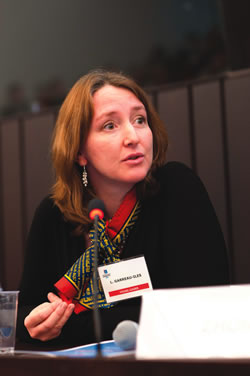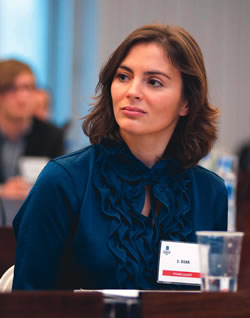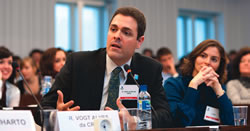|
|
Vol.
34 No. 3
May-June 2012
 |
| Young Leaders Lucie Garreau-Iles (France, above) and Albert Sugiharto (Indonesia/Germany), at the IYC Closing Ceremony in Brussels. |
 |
How can chemistry tackle global challenges by the year 2050? This is the question the Young Leaders Team set out to answer during the International Year of Chemistry. Here we find the results of their deliberations, and time-travel to 2050 for sneak-peek interviews with future winners of Nobel Prizes in Chemistry.
Under the auspices of the International Year of Chemistry, 13 young professionals working in the chemical sciences came together as the Young Leaders Team to reflect on the theme of the Year: Chemistry—our life, our future. In December 2011, our team presented the results of this deliberation at the Closing Ceremony of the International Year of Chemistry. This article summarizes the vision of how chemistry will tackle our global challenges between now and the year 2050.
Before focusing on the future of chemistry, it is helpful to ask “Where is chemistry in our life today?” Chemistry constitutes the basis of life and all nature. Although chemistry is often associated with chemical factories and with products such as paint and oil, chemistry also encompasses everything in nature, the cooking of food, and the metabolic processes in our body. Chemistry ensures that we have sufficient food that has a long shelf-life and is safe; that we have medicines to prevent and treat everyday illnesses and serious diseases; that we have heat and power; that we can buy personal-care products and clothing; and that we have continual access to telecommunication, media, and music wherever we are.
Where will chemistry be in our life tomorrow? Answering this question led us to envision ourselves in 2050. Global, sustained and macro-economic forces of development, commonly called “megatrends,” will impact businesses, economies, societies, cultures, and our personal lives in our future. What do we know about this future?
We know that global population will increase from 7 to 9 billion people and that 75 percent of people will be living in cities, up from 50 percent today. This will translate into an explosion of consumption, accelerating the usage of energy and finite resources, with severe consequences for the health of our planet. Higher density may cause pandemic health risks to rise, while the level of chronic disease among an aging and ever-more-mobile population is expected to grow.
Whilst these megatrends will clearly affect humankind, they will not do so uniformly. Below, we illustrate how the developed, developing, and least-developed parts of the world will experience these megatrends in different ways, and how chemistry will address some of the fundamental impacts during the next 40 years. Despite the magnitude and differential effects of these changes, we all firmly share the common vision that by 2050, everyone on the planet must have access to a healthy, safe, and fulfilled life in symbiosis with our planet. We also believe that chemistry, along with other sciences, will play a leading role in fulfilling this vision.
Our team quickly focused on the key issues where the innovative power of chemistry is most needed and potentially impactful in the next 40 years: food and water, urban habitat, energy and resources, and health. We suggested not only some of the technological breakthroughs, but also the right policies, that will lead to Nobel Prizes in Chemistry being awarded in 2050 to the following three collaborative projects.
The nexus between food and water is important. It is estimated that nearly 1 billion people went hungry in 2010.1 It is anticipated that if the world’s population grows to 9 billion by 2050, at least a 70 percent growth in global food production will be required. Agriculture currently accounts for 70 percent of fresh water use.2 As global food production increases, demand for fresh water will increase. Increasing the efficiency of water for agricultural use will provide two benefits.
The first is “more crop per drop of water.” Minimizing water use for food also frees up fresh water supplies for drinking and other uses such as energy. This is critical, as currently 1 in 8 people do not have access to safe, clean drinking water.3 Chemistry can enable the development of technologies such as new drought-resistant crops and seeds in addition to fertilizers that use less water in farming.
 |
| Young Leader Jacqueline Dias (Portugal/Sweden) at the IYC Closing Ceremony. |
In parallel, we also see the role of chemistry in producing fresh water. Chemistry will be critical in developing inexpensive water purification techniques such as filtration and disinfection. An example would be a low-cost and robust membrane for filtration. While water purification technology exists today, many of these technologies are not accessible to all global markets, and a chemistry breakthrough is needed to provide a solution that is readily scalable and accessible to all.
Beyond purification, chemistry can also aid in the development of robust piping materials for highly efficient transport of water to multiple regions, in particular those in which water is scarce and unsuitable for farming.
Without the proper mechanism for technology deployment, these solutions will not be impactful. Successful implementation of these improvements in agrotechnologies and water is critical and will require three steps. First, industry and academic research institutes must be committed to developing better agricultural production systems and water-purification techniques. Second, governments must provide support for fundamental research and new technology development. Infrastructure development is key in order for these technologies to be sustainable, and efforts must be integrated at national and international levels. Third, local farmers and communities must be well-educated and informed of new technologies and the latest irrigation techniques.
Through collaboration and commitment, industrial, academic, and government sectors can implement chemical breakthroughs to meet future demands for food and water.
The urban habitat is the epicenter of several critical challenges, encompassing urban infrastructure, mobility, and consumption patterns. These are all areas where innovation in chemistry will be needed.
More than 3 billion additional city-dwellers, all aspiring to a modern lifestyle, are expected to emerge in the next 40 years,4 driving up demand for a whole range of resources. This soaring demand and resource usage will occur at a time when finding new natural resources and extracting them will become increasingly challenging, and when humankind will have to reduce its carbon emissions to manage climate change within a sustainable level. So, both of the following are needed: an increase in the supply of resources; and a step change in the way that resources are extracted, converted, and used.
The scope of the challenge is enormous. Cities will have to try to attain a zero-carbon footprint, and ideally a zero-resource footprint as well. Towards this goal, building energy efficiency and fuel efficiency will be the highest priorities.
If captured in full, raising the energy efficiency of buildings would reduce energy demand by 20 percent more than the global use of energy by shipping and air transportation combined.5 Such an improvement represents 30 percent of the team’s proposal for energy reduction. Chemistry will play a key role in this process by enabling:
- insulation, such as phase-change material and energy-efficient glazing, for passive regulation of indoor temperatures in buildings
- electronic materials, such as photonic chips, for intelligent communication systems
- zero-emission technologies for decentralized and renewable power generation, which can be integrated into buildings (e.g., resins and composite materials for wind turbine blades, structural and electro-active materials for solar photovoltaic cells)
Second, the potential for increasing fuel efficiency in the transportation sector, particularly for internal combustion engines, is phenomenal. Since it is likely that 75 percent of all vehicles will still have this type of engine by 2030,6 improving their fuel efficiency is critical. Chemistry can help to make cars lighter and it will be essential for scaling-up of the third-generation of algae-based biofuels. Chemistry will also enable the mass deployment of electric and hybrid vehicles by providing advanced materials for the new batteries and energy management systems.
But chemical innovation will not solve these challenges alone. Business can drive the innovation, but only if governments and policymakers adopt the following measures:
- friendly policies to accelerate the deployment of less resource-intensive innovation (e.g., solar feed-in-tariffs, direct capital investment in existing building retrofits, new building codes) and mitigate the negative effects on stakeholders from the transition process
- enforcement of a cradle-to-cradle lifecycle impact assessment on existing products and technologies to take into account their full environmental cost (e.g., carbon tax, total carbon footprint accounting)
- long-term investment in education—not only in the sciences, but also through consumer and business awareness—that encourages and accelerates changes in personal behavior that will lead to lower resource use
- long-term funding commitment to fundamental research so the seeds of tomorrow’s innovation will sprout
 |
Chemistry plays a major role in managing our health. It is projected that, by 2020, the USA will spend 685 billion USD per year in direct medical costs for people with chronic diseases. By 2050, this figure may become as high as USD 906 billion.7 For example, as many as 16 million people could be affected by Alzheimer’s disease by 2050.8
The early detection of the onset of chronic diseases such as Alzheimer’s or Parkinson’s by using innovative technologies could have an enormous impact, especially if integrated with systems that are able to produce and release the vital compounds that are lacking in these life-debilitating pathologies. A similar solution could be applied to infectious diseases as they account for EUR 1.5 billion in healthcare costs per year.
 |
| Rui Vogt Alves da Cruz (Brazil), Young Leader, makes
a point at the Closing Ceremony. |
A joint effort between chemistry and the life sciences could enable the development of technologies such as a bacterium that produces and delivers biomolecules to compensate for a patient’s deficiency (e.g., in stopping cancer propagation, in delivering dopamine against Parkinson’s disease). This could expand further to predictive medicine, ensuring that timely, targeted treatment is delivered to the right patient. In this area, an example would be to develop a biomaterial that monitors the full protein expression pattern before the onset of the disease.
There is a need to move from a medical approach, primarily based on disease treatment, to an integrated approach in which prevention, cure, and disease management are merged into one personalized healthcare continuum. Such a transformation would trigger a revolution of health policy and reimbursement strategies. It would also require a change in the way that patient data is handled, to ensure privacy. While allowing the use of patient data for preventative actions, a personalized healthcare approach would have to guard against misuse (e.g., using to determine a person’s eligibility for insurance, jobs, housing, and social benefits). To enable such a change, education for public understanding and cross-sector collaboration are essential.
The Young Leaders Team includes Guillaume Baxter (France), Sacha Debleds (France), Jacqueline Dias (Portugal/Sweden), Lucie Garreau-Iles (France), Nahrain Kamber (USA), Parag Kulkarni (India), Laetitia Malphettes (France), Hisham K. Mubarak (Egypt/Germany), Jean-Etienne Poirrier (Belgium), Albert Sugiharto (Indonesia/Germany), Kaihsu Tai (Taiwan/UK), Rui Vogt Alves da Cruz (Brazil), and Jingyi Zhong (China). Any views presented herein are solely those of the Young Leaders and do not necessarily represent those of their respective companies or organizations.
- FAO (2010) The State of Food Insecurity in the World: Addressing Food Insecurity in Protracted Crises.
- Unesco et al. (2006) Water—A Shared Responsibility: The United Nations World Water Development Report 2, page 173, citing UN Millenium Project (2004) Interim Report of Task Force 7 on Water and Sanitation.
- Unicef, World Health Organization (2008) Progress on Drinking Water and Sanitation: special focus on sanitation.
- United Nations Department of Economic and Social Affairs (2009) Population Division World Urbanization Prospects: The 2009 Revision: Highlights.
- Diana Farrell and Jaana Remes, McKinsey Global Institute (2008) The Energy-Efficiency Opportunity; and Fraser Thompson, McKinsey Global Institute (2011) Setting priorities for resource productivity.
- Thomas A. Becker, Ikhlaq Sidhu, Burghardt Tenderich, Center for Entrepreneurship and Technology, University of California, Berkeley (2009) Electric Vehicles in the United States: A New Model with Forecasts to 2030.
- Institute for Health and Aging, University of California, San Francisco (1996) Chronic Care in tAmerica: A 21st Century Challenge.
- Jeffrey L. Cummings, Greg Cole (2002) “Alzheimer Disease” J. Am. Med. Asso. 287(18):2335–2338.
- European Centre for Disease Prevention and Control (2008) The bacterial challenge: time to react: A call to narrow the gap between multidrug-resistant bacteria in the EU and the development of new antibacterial agents.
Unless otherwise noted, all photographs are by Vivian Hertz.
Interview with Mr. Al-Amal, Director of Nigeria AgroChem, Nobel Prize in Chemistry 2050
Mr. Al-Amal, congratulations on your Nobel Prize. As the director of the Nigerian AgroChemical Corporation, you are the first industrial leader ever to be awarded the Nobel Prize. How does it feel?
It is a great honor to receive the Nobel Prize for helping meet the world’s growing needs for food and water. The low-cost water purification unit my team developed over the last decades is the result of close cooperation between academia, government, and industry. The technology has now been implemented globally. My work was dedicated to finding chemical solutions to the water problem—I never dreamed of winning the Nobel Prize.
You graduated in 2016 as a chemical engineer. How did you first get into the water problem?
After graduating in my home country of Egypt, I joined a major agro-chemical company. I was involved in several projects to develop drought-resistant seeds with better crop yield. These seeds required less fresh water to irrigate, and the resulting crops had a higher chance to survive without irrigation. We were very successful in the crop market. I thought I had found a solution to the food problems we had in Africa; however, I had yet to grasp the full challenge or see the big picture.
“The big picture”—what do you mean?
In 2019, I was tasked with increasing the sales of chemically enhanced seeds across Africa. I was, therefore, transferred from Egypt to Nigeria where I quickly made friends with the local farmers. I learned that enhanced seeds could help increase the crop yield in their fields. There was, however, a major problem to be solved: The lack of clean water for irrigation. The River Niger could provide enough water, but that water was spoiled by oil spills. The use of Niger water for irrigation would mean that the farmland would be polluted and the crops would be spoiled.
What was your approach to solving the irrigation problem? I recall that, in the 2020s, water filtration technology was still too expensive for a place like Nigeria.
That’s exactly the point. Our company held patents in membrane-based water filtration technologies, but they were much too expensive to commercialize in these target markets. We could not solve the problem alone. This was upsetting to me, as I felt the urgent need to help my farming friends by providing a solution to their local irrigation problem.
The development of technology that is cost-prohibitive is an experience many industrial chemists encounter. How did you overcome this roadblock? Did chemistry play a role?
A turning point came in 2024, when the Nigerian government started a number of research initiatives for water purification technologies. Together with the Nigerian government, my company engaged in a public-private partnership. Our goal was to create a water purification technology that was affordable to Nigerian farmers, and easy for them to maintain themselves.
Our breakthrough came in 2027, when I was working on a new kind of filter. My vision was to find a material that could filter out dirt from the water, while neutralizing microbes in a reaction catalyzed by the filter material itself. While conducting my own research, I discovered that one of the local plants had the right germicidal effect. It was possible to use the plant fiber as a filter material. Based on this discovery, we developed a low-cost, self-contained water treatment unit which could be easily cleaned by any farmer in the field.
The Nigerian government quickly adopted the technology and provided it at no cost to the local farmers. At the same time, the government constructed a new pipeline infrastructure made of self-sealing polymer material. This new, robust pipeline allowed the transport of water over long distances, with almost no loss. After this first success, I worked hard to spread this water filtration technology around the world. Beginning in Africa, we set up cooperation projects all over the world. As you can see, in both purification and transport of water, chemistry played a key role.
Thank you for these insights. Could you summarize the most relevant factors behind this success?
Let me point out three components that were crucial. Our success was based on chemical innovations that are supported by other sciences. To bring them into use, we needed people with sound academic and practical education. This was made possible only through close cooperation among partners in industry, government, and academia. The outcome shows that when all three sectors come together, success is inevitable. |
Interview with the Mayor of Xi’an, Nobel Prize in Chemistry 2050
Hello Mayor, congratulations on your Nobel Prize. Xi’an today is one of the first self-sufficient, zero-footprint cities in China. It was quite a big transformation.
Yes, as the Mayor of Xi’an, I am very proud to say that Xi’an is now the eco-city model for the rest of China and for the world.
We will come back to Xi’an later. Maybe we can start to talk a little bit about you, where do you come from in China and how did you get into chemistry?
I was born in Xi’an in 1990. This was how my interest in chemistry was piqued: When I visited the world-famous Terracotta Army in Xi’an at the age of 15, I could not believe that these sculptures were over 2000 years old. But then I learned the method of age determination by 14C. There and then, I decided to become a chemist to discover this amazing field of science.
You graduated in 2011 as a chemist and started to work for the Dongtan project. Tell us a little bit about this project?
During the first decade of the 21st century, China was enjoying an economic miracle. But to enable this miracle, one coal power plant was opening almost every week. By the end of the decade, China became the biggest CO2 emitter in the world. China realized the serious environmental damage caused by this development and started to invest in projects to reduce its intense energy and carbon usage. The most ambitious one was the Dongtan site, the first eco-city development in China.
So you started to work as a chemist for the Dongtan project, but in 2020 you joined the Xi’an municipal authority, what made you change your career from a chemist to a politician?
When I was involved in the Dongtan project, my job was to bring the chemical industry and academia together to work on a long-term “cross-seasonal” thermal-energy storage system. In this project, I realized the essential role of the Chinese government in completing the project. If chemistry is key, the government puts the key into the door. Then, in 2020, I learned that my home town of Xi’an was to become one of the planned eco-cities in the Vision 2050 established by the Chinese government. This is why I decided to work in the municipal authority.
As we know, a Nobel Prize in Chemistry was awarded to you for your contribution to promoting the chemistry in the Eco-Xi’an project. Could you please explain in more detail the role of chemistry in the realization of Eco-Xi’an?
Over 30 years, the transformation of Xi’an was impressive. Chemistry was key to this development, but it did not act alone. There were three important pillars: innovation, lifestyle, and governance. Chemistry was a main contributor to the first two pillars. Let me mention some examples:
Innovation in chemistry played a key role in the development of Xi’an as an eco-city: a sponge, based on nanotechnology, is used on the top of the buildings to absorb the pollutant particles; artificial photosynthesis systems are used to produce the biofuel and energy by converting CO2 and light; cross-seasonal thermal storage is used to keep the summer heat for use in winter; and efficient chemical processes are used to produce the materials, which makes everything I just mentioned affordable.
As for the urban lifestyle, we pioneered a smart infrastructure that combines high-purity chemical compounds and information technology, connecting electromobility in the city. We developed a symbiosis between chemical plants and habitat, with safety management systems. And we optimized the recycling process, allowing the reuse of over 90 percent of the waste created in Xi’an.
Good governance means the right mix of incentive- and eco-based fiscal policies. It also means education programs encouraging the younger generation to embrace science and engineering. Dedicated public communication programs are indispensible if we want to change the mindset and lifestyle of citizens.
So chemistry plays a key role, but chemistry cannot do it all alone. To end this interview, would you describe in one sentence the most important factor in the achievement of Eco-Xi’an?
I want to say that we have succeeded because government, academia, industry, as well as citizens bonded together. |
Page
last modified 30 April 2012.
Copyright © 2003-2012 International Union of Pure and Applied Chemistry.
Questions regarding the website, please contact [email protected] |